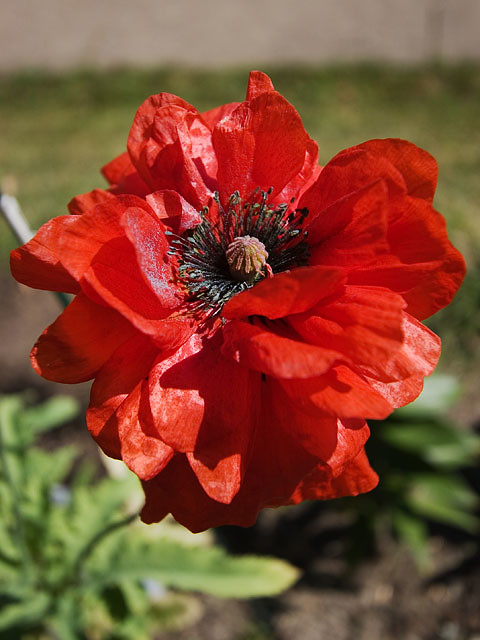To: exDemMom
I didn't know that, thought they had to be closer genetically to cross. Thank you for explaining it.
It's not the same as what you explained, but I thought of this beauty that came up by chance with some seeds (I don't remember what, Canterbury Bells I think) that failed to germinate from winter sowing in a cut off gallon milk jug. It had lodged in a crack by the wall of the jug and soil.
This was September, and all poppies had long since quit blooming. When I saw the drooping bud, I knew I had a poppy and set it in the sun to see if it would bloom. It did in a day or two.
In excited anticipation, I was looking forward to it self pollinating and producing seed, and shared it on a garden forum. Was disappointed to learn that poppies, this type at least, don't self-pollinate, forget what the word for it is. So I was crushed, have never seen any red poppies quite like this, but there must be some somewhere.

A plant scientist might have gotten it to grow by some other means, but I had to enjoy the beauty of it while it lasted and let it go. So sad when I remember that. There are cloners you can buy, I didn't have one and doubt that would have worked but people talked about how they got certain plants to propagate in cloners.
If I could live my life over again, I'd like to work more with plants but not particularly in a commercial greenhouse or nursery but on my own projects somehow self-funded. I think I would do it the way Mendel did plus cloning and cuttings but I don't think I'd want to tamper with genetic manipulation.
61 posted on
12/08/2017 6:42:16 PM PST by
Aliska
To: Aliska
Your flower was really beautiful.
Once, my husband was out mowing and found a little weed with brilliant red flowers, which he pulled up and brought inside to me. I put it in a pot and had it for a few months.
I later found out it was a portulaca. I’ve never seen another one with those brilliant red flowers.
Any kind of manipulation of a plant to change its appearance or growth habits by any means results in genetic modification.
In the early 1900s, botanists used to induce mutations by bombarding seeds with radiation. If the seeds survived and grew, they kept the plants with the most desirable traits. In many cases, the seeds of the descendants of those “radiation hybrids” are still sold, still grown commercially. Considering some of the kinds of damage caused by ionizing radiation, I think the chromosomes of those radiation hybrids may be quite different from the parent plants.
When I was a kid, I used to like visiting the Luther Burbank museum and garden in Santa Rosa, CA. He was more of a hobbyist than anything else. He developed over a hundred hybrids, but did not keep good notes and many of the hybrids have been lost. He came up with the Russet potato that is still quite popular, and the Shasta daisy.
62 posted on
12/08/2017 9:39:03 PM PST by
exDemMom
(Current visual of the hole the US continues to dig itself into: http://www.usdebtclock.org/)
To: Aliska; metmom; greeneyes
Aliska :" So I was crushed, have never seen any red poppies quite like this,
but there must be some somewhere."
Get yourself some fresh "Rootone", "Bonide" , or similar rooting compounds and make your own cuttings .
You might be able to perpetuate the species and the qualities that you like thru experimental cross-breeding.
Met-Mom is quite correct about the Cavendish banana - I believe that genetics allow for some 42 genetic generational cuttings,
so it's commercial value declines as its genetic resistance to disease declines.
To: Aliska; metmom; greeneyes
Aliska :" So I was crushed, have never seen any red poppies quite like this,
but there must be some somewhere."
Get yourself some fresh "Rootone", "Bonide" , or similar rooting compounds and make your own cuttings .
You might be able to perpetuate the species and the qualities that you like thru experimental cross-breeding.
Met-Mom is quite correct about the Cavendish banana - I believe that genetics allow for some 42 genetic generational cuttings,
so it's commercial value declines as its genetic resistance to disease declines.
FreeRepublic.com is powered by software copyright 2000-2008 John Robinson
